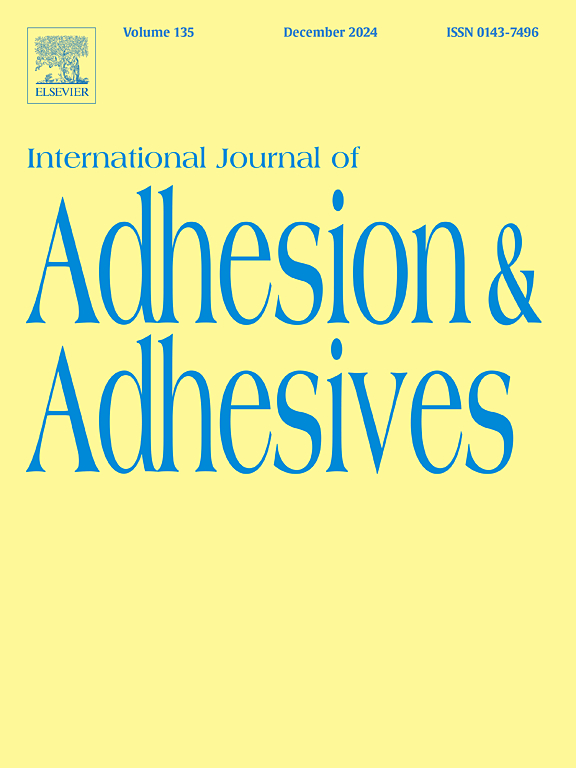评估复合树脂-陶瓷修复体的粘接失效:实验室研究和临床试验的系统回顾
IF 3.5
3区 材料科学
Q2 ENGINEERING, CHEMICAL
International Journal of Adhesion and Adhesives
Pub Date : 2025-05-08
DOI:10.1016/j.ijadhadh.2025.104048
引用次数: 0
摘要
背景:复合树脂-陶瓷修复体的粘接失败仍然是修复牙科的一个关键挑战。尽管材料和技术取得了进步,但在杂化陶瓷和牙齿结构之间实现可靠和持久的结合仍然是一个问题。了解各种粘连方案、引物、粘接剂、树脂水泥和表面预处理的影响对改善临床结果至关重要。目的本系统综述的目的是评估混合陶瓷修复体的粘接失效,并比较不同粘接方案、材料和表面预处理的有效性。方法对19项体外研究和2项随机对照试验进行综合评价。根据粘接方案、底漆、胶粘剂、树脂水泥和表面预处理,对粘接失效的失败率和原因进行了分析和分类。结果修复体与牙结构交界面粘接剂失效较多。在不同的粘附方式下,失败率从7%到15%不等。喷砂联合硅烷偶联剂的失败率为7 ~ 15%,氢氟酸蚀刻联合硅烷偶联剂的失败率为10 ~ 15%。通用胶粘剂的故障率为8 - 14%。自粘树脂水泥的失败率为8 - 13%,全蚀刻技术的失败率为7 - 14%,热循环导致的失败率为9 - 15%。长期蓄水导致故障率为7 - 15%。牙齿结构的基材预处理方法也显著影响粘合剂失效,其中氢氟酸蚀刻和喷砂是最有效的,但随着时间的推移也容易降解。结论复合陶瓷修复体的粘接失败与粘接方式、底物、粘接剂、树脂胶结剂和表面预处理的选择有显著关系。优化这些因素,选择最佳的技术和材料对于提高粘合强度和耐久性至关重要。由于研究设计和结果的可变性,无法进行荟萃分析,这强调了在未来的研究中需要标准化的研究方法。本文章由计算机程序翻译,如有差异,请以英文原文为准。
Evaluating adhesive failures in hybrid resin-ceramic restorations: A systematic review of laboratory studies and clinical trials
Background
Adhesive failures in hybrid resin-ceramic restorations remain a critical challenge in restorative dentistry. Despite advancements in materials and techniques, achieving reliable and durable bonds between hybrid ceramics and tooth structures continues to be problematic. Understanding the impact of various adhesion protocols, primers, adhesives, resin cements, and surface pre-treatment are essential to improve clinical outcomes.
Aim
The purpose of this systematic review was to evaluate the adhesive failures in hybrid ceramic restorations and compare the effectiveness of different adhesion protocols, materials, and surface pre-treatment.
Methods
A comprehensive review of 19 in vitro studies and 2 randomized controlled trials was conducted. Failure rates and causes of adhesive failures were analyzed and categorized based on adhesion protocols, primers, adhesives, resin cements, and surface pre-treatment.
Results
Adhesive failures were frequently observed at the interface between the restoration and tooth structure. Failure rates ranged from 7 % to 15 % across different adhesion protocols. Grit-blasting combined with silane coupling agents showed failure rates of 7–15 %, while hydrofluoric acid etching combined with silane coupling agents had failure rates of 10–15 %. Universal adhesives exhibited failure rates of 8–14 %. Self-adhesive resin cements showed failure rates of 8–13 %, total-etch techniques had rates of 7–14 %, and thermocycling resulted in failure rates of 9–15 %. Long-term water storage led to failure rates of 7–15 %. Substrate pre-treatment methods of tooth structure also significantly influenced adhesive failures, with hydrofluoric acid etching and grit-blasting being the most effective but also prone to degradation over time.
Conclusion
Adhesive failures in hybrid ceramic restorations are significantly influenced by the choice of adhesion protocols, primers, adhesives, resin cements, and surface pre-treatment. Optimizing these factors and choosing the best techniques and materials are crucial for enhancing bond strength and durability. The inability to perform a meta-analysis due to variability in study designs and outcomes underscores the need for standardized research methodologies in future studies.
求助全文
通过发布文献求助,成功后即可免费获取论文全文。
去求助
来源期刊

International Journal of Adhesion and Adhesives
工程技术-材料科学:综合
CiteScore
6.90
自引率
8.80%
发文量
200
审稿时长
8.3 months
期刊介绍:
The International Journal of Adhesion and Adhesives draws together the many aspects of the science and technology of adhesive materials, from fundamental research and development work to industrial applications. Subject areas covered include: interfacial interactions, surface chemistry, methods of testing, accumulation of test data on physical and mechanical properties, environmental effects, new adhesive materials, sealants, design of bonded joints, and manufacturing technology.
 求助内容:
求助内容: 应助结果提醒方式:
应助结果提醒方式:


